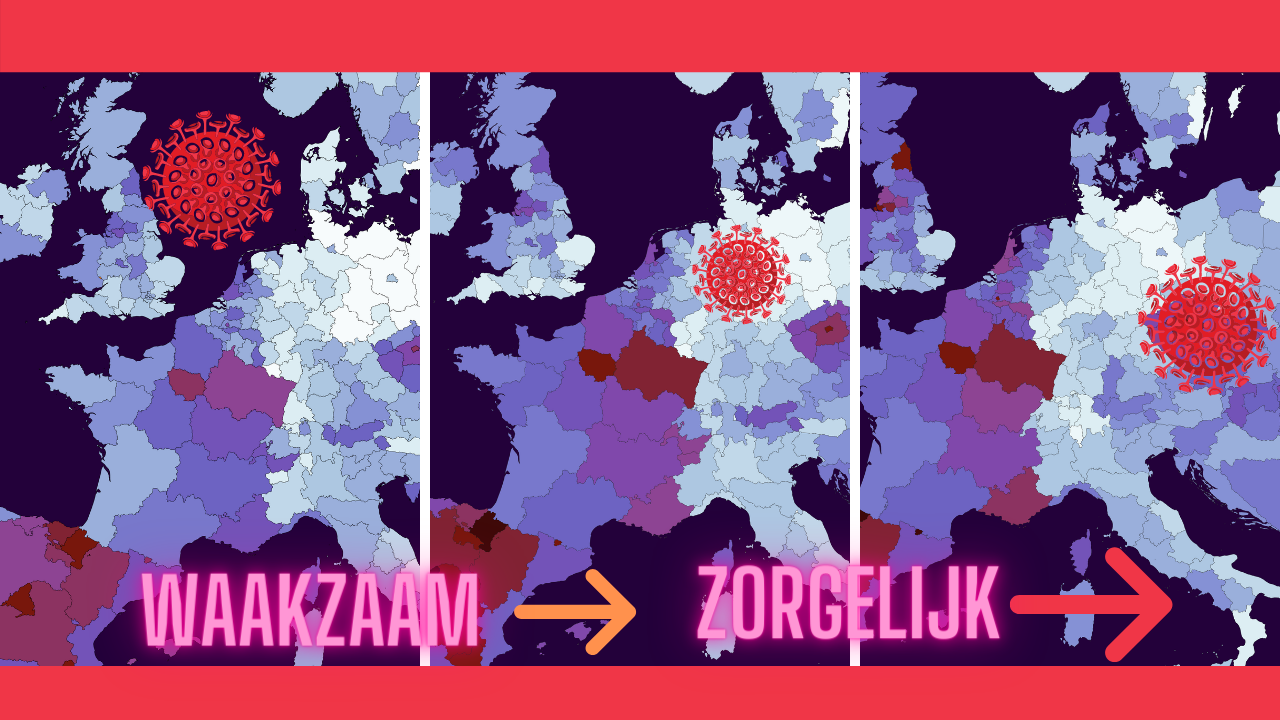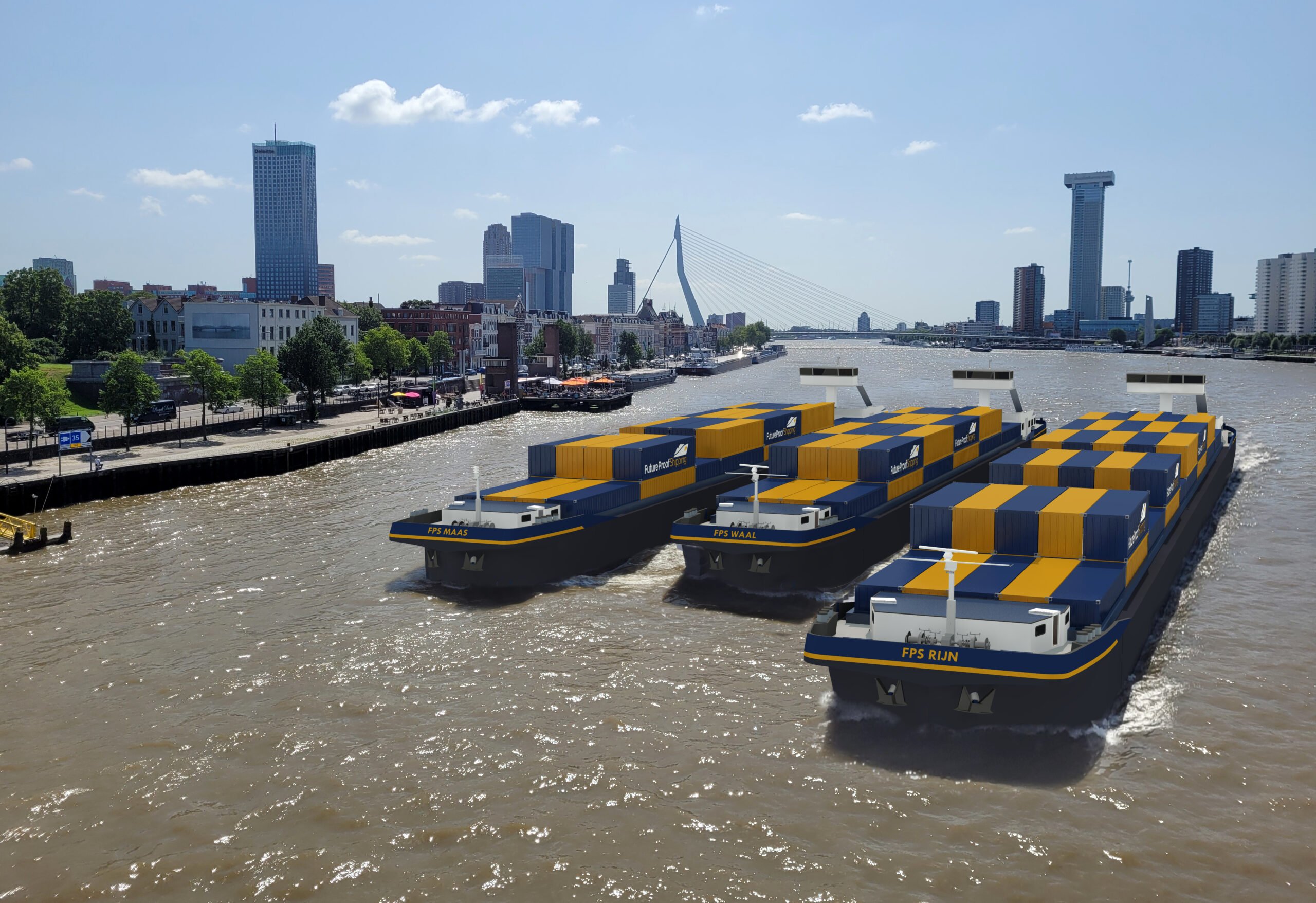
The autumn wave is plowing across Europe with unprecedented speed. In almost every European state, the growing number of corona infections and increasing concerns are commonplace. The continent is facing a number of weeks of truth. Positions are being prepared and armies of care workers are being brought to the highest state of readiness.
Read last week’s analysis here.
The trend is also clearly visible on the maps of Europe. Spain seems to be the first victim with rising infection rates and now overburdened hospitals as well. France, the Czech Republic, Belgium, the Netherlands, and the United Kingdom also have to work hard to keep this wave in check.
This becomes immediately clear after a look at the sliders below which juxtapose the number of infections from September 20 to 26 next to those of the previous two weeks. The third map shows the proportion of positive corona tests from Our World in Data.
Lots of tests = Lots of diagnoses
Spain and Montenegro were the absolute corona leaders of Europe over the past week. Madrid is the worst hotspot, with 26,664 new infections in seven days. Good for 400.2 per 100,000 inhabitants. Plus a new darker color on the map because an increase like this is once again a tragic record.
Other countries where it is in danger of going in the wrong direction at the end of September are the Czech Republic, France, Belgium, and the Netherlands. In fact, the increase is noticeable everywhere. Only Latvia and Finland managed to keep their average very low. Denmark and the United Kingdom are rising rapidly. Although this seems to be more a result of a the higher numbers of of tests. It should come as no surprise that countries who take a lot of nasal swabs from their populations, invariably register a lot of new infections. As a result, Denmark and the United Kingdom color quite dark on the infection map. However, as seen on the charts below, they score very well when it comes to the number of positive tests in relation to the number of tests carried out.
The timeline also shows that the proportion in these countries is increasing much less rapidly than in other Western European countries. Not a single country is currently below the 3% threshold as stipulated by the ECDC. If a country is above this percentage, it may be an indication that not enough testing is taking place. This had disastrous consequences in the spring.
The Dutch lion caught unawares
The country at the center of this corona crisis in Europe is the Netherlands. How can one of the richest EU countries with excellent laboratories fare so badly in the autumn wave? This is not only due to insufficient testing. Nor about scaling up too late. Or the competition between testing labs, (about which plenty has already been written). Rather it can be blamed to a large extent on communication. This is where (a lack of) vision, decisiveness, and leadership within the Dutch corona strategy becomes painfully clear.
The best time for Dutch communication on corona was back in the early days. The first series of speeches by Prime Minister Mark Rutte about stopping it were very clear and well received. The country was presented with a concrete package of measures which was also clearly communicated. This was accepted by a large majority of the population.
Yet not everything went well even in March. When Rutte attempted to explain that the Netherlands was aiming for herd immunity, this was interpreted as the disputable ‘Swedish’ approach. The herd immunity strategy promptly led to criticism. It seems that the Netherlands government was prepared to play with the lives of millions of people while a still unknown virus was given free rein to infect and kill as many people as it could.
Which all turned out to be a misunderstanding. In fact, the Netherlands was not aiming for herd immunity in that respect at all. In reality, the government opted for a strategy that encompassed a gradual spread of the virus, except without a strict lockdown. Herd immunity was the eventual goal here. Criticism soon subsided once more. But the first traces of a deeper communication problem became clearly visible.
Easing, exemptions, experiments, and doubts
While little changed in April and May in terms of policy and communication, life in the Netherlands was relatively relaxed compared to many other European countries. Stores and businesses remained open and there was never any obligation to self-quarantine. Despite the difficult period in which everyone had to adapt, satisfaction with the government policy was quite high. The Netherlands had comparatively few corona violations. The prime minister Mark Rutte stood with a record of 43 seats in the polls in May.
On June 1, ‘we were allowed out again.’
The government eased a number of restrictions and came up with a series of ‘explicit’ guidelines. And promised that in a month’s time everyone could be tested for the virus. And this is where it all went wrong.
For instance, the Netherlands introduced a mandatory face mask requirement that only applied to public transport. This despite the fact that Jaap van Dissel from the Dutch National Institute for Public Health and the Environment (RIVM) had repeatedly insisted that ‘these things would not work at all‘. Lobby groups jumped at the chance to demand exemption status as part of the easing of restrictions. What’s more, a ‘compulsory health check‘ for hospitality guests was scrapped and airlines were allowed to ignore the rules altogether.
Common sense as the guiding principle?
This wild proliferation of exemptions and easing of restrictions mainly led to a lot of confusion and frustration. This confusion came on top of the series of ‘explicit advice’ given by Mark Rutte and Hugo de Jonge. The guiding principle was that ‘common sense’ would prevail. The assumption was that the population would naturally behave appropriately, That way, strict enforcement of the rules and obligatory measures would not be necessary.
A similar strategy is in place in Scandinavia. Here there are a number of basic rules with a set of explicit recommendations. The problem is just that the Dutch are not Scandinavians. In Northern Europe, there is a much stronger sense of egalitarianism, a we-feeling, than in the very individualistic Netherlands where anything and everything can be negotiated. This is quite different in Italy or Portugal, where the police intervene harshly in the event of violations.
The vague communication and the disappearance of corona from the streetscape led the Dutch to believe that even the basic rules were apparently no longer necessary. Sappy commercials that said ‘you’re done with corona, but corona isn’t done with you‘ were mocked primarily because of the clichéd language. Whereas in Scandinavian countries simple messaging without too many ifs and buts took center stage, it was a mess in the Netherlands. The poster below also proves that it all started out quite well.

Hugo de Jonge: from CDA crown prince to eating humble pie
Inconsistency, invisibility, and lack of clarity reduced support during the summer months. When a government comes across as a strong crisis manager who has the situation under control and keeps its promises, it is repaid in public confidence. Trust is something that you build up slowly and quickly lose. It is perhaps the most valuable building block for a successful communication strategy. The quickest way to destroy trust? Fail to keep promises. A matter in which Minister Hugo de Jonge, in particular, played a dubious leading role.
Using clichéd management jargon, De Jonge tried to make terms such as ‘instrument case’, ‘escalation ladder’, ‘roadmap’, and ‘regional customized approach’ just as iconic as ‘June 1’ or ‘meter-and-a-half rule’. Meanwhile, far too late, his ministry launched a faltering dashboard that resulted in more questions than clarity. It also transpired that the development of a corona app turned into an embarrassing neverending debacle. And it soon became clear that he could not keep his promise that ‘anyone could get tested’ as of July 1. At the same time, the 25 GGDs (Dutch Public Health Services) began to make their own wilful (sometimes downright counterproductive) decisions.
Dutch governmental corona task force on vacation
For a while the virus didn’t seem to exist during summer. The Netherlands went from ‘lockdown’ to ‘vacation’. Hugo de Jonge passed the regional customized strategy onto the plates of the security regions so that the Cabinet’s corona task force could go on vacation. The plan was that the security region teams would be able to experiment with regional restrictions of their own. What did this mean exactly? No idea. The mayors of the security region areas couldn’t do much with this. They also felt overwhelmed by the extra tasks they had not asked for. This also resonated with the rest of society, who were now completely in vacation mode. Quarantines for travelers from high-risk regions? Not compulsory, but strongly advised.
As a result of failed experiments with face masks in Amsterdam, a floundering testing lane at Schiphol Airport, and an ‘unforeseen’ resurgence of the virus in mid-July, with cabinet members having to return from vacations earlier than expected, confidence in the Dutch ‘intelligent lock-down strategy’ crumbled further and further. All the while, opportunistic ‘corona critics’ profited from the ambiguity that increasingly manifested itself in anger. Not only on social media but in the streets as well.
Who is the boss?
Who is the main person responsible for the Dutch corona approach? The OMT, RIVM, GGD, Cabinet, Safety Region authorities, or the mayor? This never really became clear and became worse when decentralization began to play a greater role.
The current wave could perhaps have been avoided if pro-active policies had been implemented immediately from July onwards. But here, too, decentralization and the prevailing ‘polder model’ culture morphed into a dithering government that could not, either half-baked or too late, act with the best communication strategists to send out a clear message. To make matters worse, the testing capacity also proved to be inadequate.
‘Anyone can get tested’ … so you say …
‘Anyone can get tested‘ changed behind the scenes into ‘anyone with symptoms can get tested’. Still, it remained far too busy at the GGD’s testing lanes, which in the meantime were struggling with staff shortages. The massive influx of ‘fun-testers‘ (people with no symptoms who got themselves tested anyway) caused the turnaround time to increase from 24 hours to 48 hours. In turn, this led to the test centers to be so overloaded that there was almost nowhere in the Netherlands where you could get an appointment.
During press conferences (where scarcely any new measures were announced), it was not only ‘fun-testers’ who were blamed for the constantly-changing policy. According to Rutte, young people did not comply very well with the (unclear) rules and ‘explicitly pliable advice’. The fact that it didn’t occur to anyone that the reach of a television broadcast among young people under the age of 25 was rather marginal fitted right in with the overall pattern too. An unambiguous social media campaign, street regulation reminders such as those in the spring, or adequate information in foreign languages, are still not available.
Stalling september
September arrived with increasingly alarming spikes. Trust was shaken once more following the wedding of the Dutch Minister Ferd Grapperhaus of Justice and Security who broke his ‘own rules’. Also, the cat was out of the bag when it came to explaining the faltering test capacity: A questionable form of protectionism or a more informal Dutch ‘test lab mafia’ was to blame. In order to reduce the pressure on the test bottleneck, ‘anyone can get tested within 24 hours’ changed within three months’ time to ‘anyone over 12 years old with symptoms can get tested within a week.’
While Germany sounded a loud alarm for exceeding 50 per 100,000 infections in one week, it remained quiet in the Netherlands. Even though North and South Holland registered more than double that number. Pubs and cafés now had to close at 1 am. The maximum group size was reduced from 100 to 50, with the exception of funerals and church gatherings. Again.
Suddenly a clearly improvised ‘escalation ladder’ with risk levels per security region was introduced: ‘cautious’, ‘concerning’, and ‘serious’. While it was still not clear what they were based on and what the consequences were. This gave the Dutch labyrinth of existing corona rules, explicit advice, countless exemptions, half-hearted decentralizations, and other hollow phrases yet another twist.
Two minutes past twelve
It was only in the penultimate week of September that the acute problem appears to have been taken seriously. Last weekend, Mark Rutte summoned his most important policymakers for a crisis meeting. It remains to be seen what they will come up with. But these decisions are crucial for the further course of the COVID-19 pandemic in the Netherlands.
Thanks to weak communication, reactive policies, explicit advice, marginal measures, finger-pointing, and the umpteenth press conference calling for ‘common sense’, the situation in the Netherlands has been transformed into a ticking time bomb over the past three months. If Prime Minister Rutte wants to prevent a lockdown, he should perhaps look back at the images of himself when he first announced the previous one.
Do we in the Netherlands want to ‘get corona under control together’? Then simple, unambiguous, consistent, and united governmental communication forms a vital foundation. This is the only way a functioning wristwatch can be forged from the current, reactive, defective timepiece with its countless loose cogs and springs. That alone will reveal that right now it is already two past twelve.








